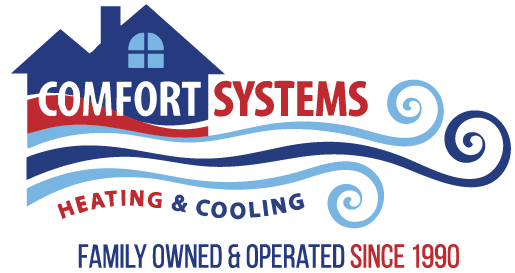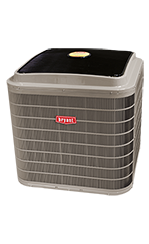
Heating and Cooling
FAQ’s and resources

At Comfort Systems Heating and Cooling, we want you to feel confident in every step of your HVAC journey. Whether you're exploring a system upgrade or need a quick repair, having the right information makes all the difference.
Purchasing a new heating or cooling system is a big decision—and one that affects the comfort of your home and family for years to come. That’s why we’ve created this FAQ page to help you make informed choices. Below, you’ll find answers to common questions about our quoting process, system options, repair experience, and more.
General Questions
-
We recommend professional maintenance twice a year, once in the spring for cooling and once in the fall for heating, to keep your system running efficiently and to catch small issues before they become big problems.
Check out our Comfort Club for specials and discounts for these types of services!
-
Most systems last 10–15 years with proper maintenance. High-quality equipment and routine care can extend that lifespan.
-
If your system is over 10 years old, needs frequent repairs, or your energy bills are rising, it might be time to consider a replacement. We offer honest assessments to help you decide.
-
Our team is made up of highly experienced professionals—many of them have been in the industry for 10+ years. We also invest in ongoing training so they stay up to date with the latest technologies and best practices. — We also have someone who has been with us for over 35 years!
Getting a Quote
-
The fastest and easiest way to get started is to give us a call at 816-322-1013 — we’ll schedule one of our Comfort advisors to meet with you, evaluate your equipment, and provide a personalized proposal.
Prefer to schedule online? Click here to request a quote or schedule your free consultation. -
11% of people choose a contractor solely on price.
Unfortunately, it is often the case that you “get what you pay for,” and the cheapest contractor delivers the least desirable product. Consider what your comfort is worth and the life span of the investment you are making. An upper-end furnace has a life span of 20 – 25 years, an upper end AC has a life span of about 15 years (air conditioners sit outside in the elements, which shortens their life span), and upper-end heat pumps have about a 13-year life span (remember your heat pump works both heating and cooling system so it works twice as hard as a conventional AC/furnace system while producing considerable energy cost savings). If you factor what you will pay for the system over the life span and factor in the savings a high efficiency system that is professionally installed can provide, the investment is very affordable. In our region, families use their heating and cooling systems an average of 10 months out of the year. This is the part of your home that creates comfort – you and your family are worth the most comfort for your budget.
-
Yes! We remove and haul away old equipment, and that is included in the total cost of your project.
Don’t see your question?
Reach out to us!
See Our Featured Brands + Products
HVAC Glossary – Know Your System
Our glossary helps you understand the key terms behind your heating and cooling systems. Whether you're learning about AFUE ratings, BTUs, or how a compressor works, this page breaks down technical HVAC language into clear, simple explanations.
AFUE
Annual Fuel Utilization Efficiency is a measure of a gas furnace’s efficiency in converting fuel to energy – the higher the rating, the more efficient the unit. For example: a rating of 90 means that approximately 90 percent of the fuel is used to provide warmth to your home while the remaining 10 percent escapes as exhaust. Another way to look at it is that a 90% efficient furnace uses 90 cents of each energy dollar to heat your home while 10 cents literally goes up the flue.
BTU
British Thermal Unit is the amount of heat it takes to raise one pound of water one degree Fahrenheit. For your home, it represents the measure of heat given off when fuel is burned for heating or the measure of heat extracted from your home for cooling.
CFM
Cubic Feet Per Minute. A standard measurement of airflow. A typical system requires 400 CFM per ton of air conditioning.
Capacity
The output or producing ability of a piece of cooling or heating equipment. Cooling and heating capacities are referred to in BTUs.
Compressor
The heart of an air conditioner or heat pump unit. It is the part of the outdoor unit and pumps refrigerant in order to meet the cooling requirements of the system.
Condenser Coil/Outdoor Coil
In an air conditioner, the coil dissipates heat from the refrigerant, changing the refrigerant from vapor to liquid. In a heat pump system, it absorbs heat from the outdoors.
Damper
Found in ductwork, this movable plate opens and closes to control airflow. Dampers can be used to balance airflow in a duct system. They are also used in zoning to regulate airflow to certain rooms.
Ductwork
Pipes or channels that carry air throughout your home. In a home comfort system, ductwork is critical to performance – in fact, it is as critical as the equipment. Ductwork that is going into an attic or crawl space should be insulated. Supply ducts with heat pumps should be insulated. Ductwork is often undersized. This compromises airflow which, in turn, compromises your comfort. We build much of our ductwork in-house, which is not common. We do this to ensure correct size and duct transitions as well as to make the ductwork look attractive. We fabricate “old school” by hand.
Evaporator Coil/Indoor Coil/A Coils
The other half of your air conditioning system, located inside your home in the indoor unit. This is where the refrigerant evaporates as it absorbs heat from the air that passes over the coil. The heat pump absorbs heat from outside for cooling and the process is reversed in heating mode. It is important for this coil to be matched to the system – not a generic non-matched brand – and to be correctly sized to the system.
Gas Furnace Heat Exchanger
Located in the furnace, the heat exchanger transfers heat to the surrounding air, which is then pumped throughout your home. This is the part that can crack and allow carbon monoxide to enter your home. It is important to have your furnace professionally serviced annually and to change your filters often to help identify/prevent heat exchanger cracks.
HSPF
Heating Seasonal Performance Factor is the rating used in measuring the heating efficiency of a heat pump – the higher the number, the more efficient the unit.
Package Unit
A heating and cooling system contained in one outdoor unit. A package unit is typically installed beside, on the roof of, or sometimes in the attic of a home or business. Package units are not common in residential applications in the greater Kansas City area but are common for light commercial application.
Refrigerant
A chemical that produces a refrigerating effect while expanding and vaporizing. The two most common types of refrigerant are R-22 and R-410A. Refrigerant is regulated by the EPA so make sure anyone dealing with your AC or heat pump is appropriately certified. R-22 is being phased out to protect the ozone. No new equipment will be manufactured with R-22 after 2010 and the manufacturing of R-22 has been phased out completely (as of 2020). We strongly recommend you consider purchasing an R-410A system if you are purchasing a new system. From a practical standpoint, as R-22 is phased out, it will become more and more expensive.
SEER
Seasonal Energy Efficiency Ratio. A measure of cooling efficiency for air conditioners and heat pumps. The higher the “SEER,” the more energy efficient the unit. The government’s minimum SEER rating is currently 13. For comparison, think of it as you would miles per gallon in an automobile.
Split System
The combination of an outdoor unit (air conditioner or heat pump) with an indoor unit (furnace or air handler). Split systems must be matched for optimum efficiency. Split systems are the most common type of system in our geographic area.
Thermostat
Also called a comfort control, a thermostat consists of a series of sensors and relays that monitor and control the functions of a heating and cooling system. The thermostat is like the brain of your heating and cooling system. Thermostats have become amazingly “intelligent” and user-friendly over the last few years. Programmable features and sensors that gauge humidity, need for more heat during start up, etc. are now available. Large digit thermostats are available for the elderly and visually impaired.
Ton
A unit of measurement used for determining cooling capacity. One ton is the equivalent of 12,000 BTUs per hour. Units in new housing are often undersized (as is the ductwork that goes with them) to save the contractor money. A rough rule of thumb is one ton of cooling for each 400 – 600 square feet. This can be heavily impacted by the amount of insulation in the home, the direction the home faces and the number of windows in the house. A heat load is one way to more accurately assess the number of tonnage needed to correctly cool your home for maximum comfort.
Zoning
A method of dividing a home into different comfort zones so each zone can be independently controlled depending on individual use and need. Zoning is a great application for two story homes or homes that have noticeable uneven heating and/or cooling in different areas of the home.

Schedule your free consultation
Unlock the comfort of your home with a free estimate for heating and cooling services with Comfort Systems Heating and Cooling. Our Kansas City local, expert team is ready to assess your needs and provide you with tailored solutions that ensure your space stays cozy, all without breaking the bank.




